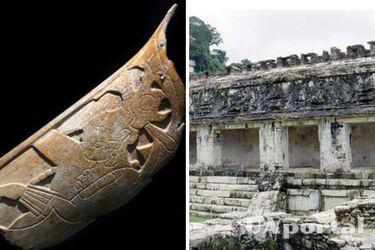Mexican scientists discover that Mayan priests decorated themselves with human bones

Representatives of the Mexican National Institute of Anthropology and History (INAH) announced an extraordinary discovery made during archaeological excavations in one part of the palace in Palenque. They pulled out a bone ornament from the soil with a carved image of the Mayan god of corn and fertility, UAINFO.org reports.
Palenque is the conventional name of the capital of the ancient Baakul Mayan kingdom. This kingdom existed during the classical period (IV-X centuries AD) and reached its heyday in the late VII century. The reasons for the decline of Baakul remain the subject of scientific research.
Today, the Palenque archaeological zone includes three temples and a palace complex. The latter consists of several buildings of various designs. Archaeologists have been conducting excavations aimed at finding traces of symmetry in the building known as House C. The preliminary hypothesis was that there was a staircase on the south side of the building.
Instead of a staircase at the base of the wall, the researchers found a floor fragment that was different from the surrounding surface. After opening the upper layer, a cavity 26 centimeters in diameter and 30 centimeters deep was found, filled with clay soil with charcoal residues.
In this cavity were found seeds, fish bones, turtles, small mammals, obsidian fragments (probably knife blades), several large pieces of charcoal, and a bone ornament among these finds. The cavity was covered with pieces of soil.
According to the archaeologists, they found a ritual offering to the gods, made in honor of the completion of the construction of House C. Researchers believe that this event took place in the Late Classic period (600-850 AD). Seeds, bones, and various objects were sacrificed and burned, and the remains were buried at the base of the wall.
The found bone jewelry (with a fragment), according to scientists, was made of the bone of a large mammal and was used as part of the ritual clothing of Palenque rulers and priests. This part of the jewelry was worn on the nose. It is small in size: 6.4 centimeters long and 5.2 centimeters wide.
Similar jewelry can be found on some reliefs and sculptures in Palenque depicting members of the nobility. In its complete form, it was a kind of mask with a ridge that ran along the nose and protruded above the forehead of its owner.
The bone jewelry was not just carved from bone. It was decorated with small ornaments. The left half of the piece was engraved with an image of a man wearing a headdress decorated with a necklace of spherical beads. The Maya glyph "ak'ab'", which means "darkness", was engraved on the left hand.
And the right arm lengthens and cuts into a crest to continue on the other side of the piece, where it holds a long, thin object.
Scientists believe that the mask depicts K'awiil, the god of corn and fertility, one of the supreme gods of the Mayan pantheon. He was traditionally represented as a man with an elongated, elongated skull symbolizing an ear of corn.
The thin object he holds in his hand is, according to researchers, a funerary scroll. Perhaps the priest, wearing such a mask, became the personification of the god during rituals, for example, in honor of the beginning or end of construction. However, in this case, it is not very clear how the fragment of the mask ended up in the pyre among other sacrificial gifts.
As a reminder, a 4000-year-old stone treasure map was found in France.
If you want to get the latest news about the war and events in Ukraine, subscribe to our Telegram channel!
